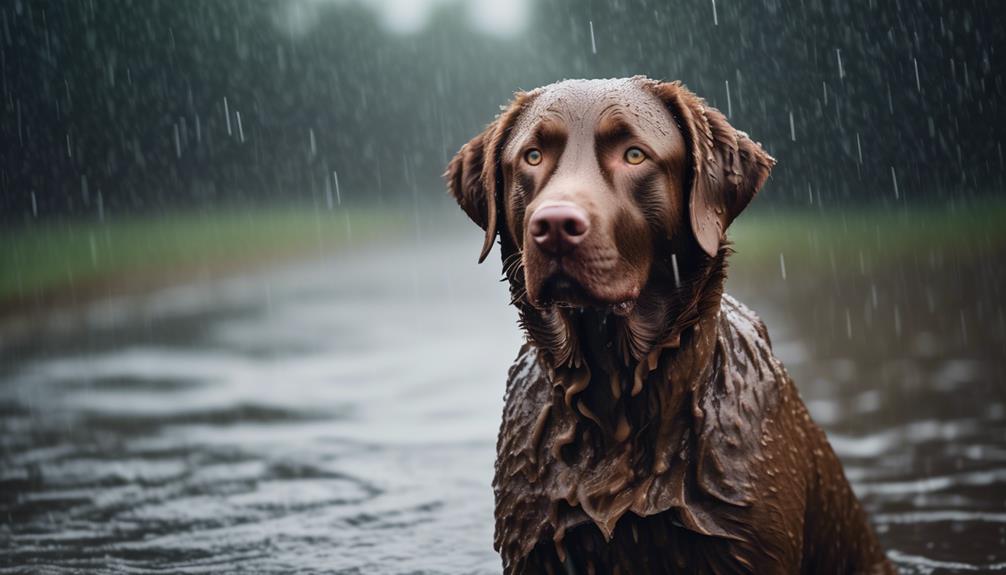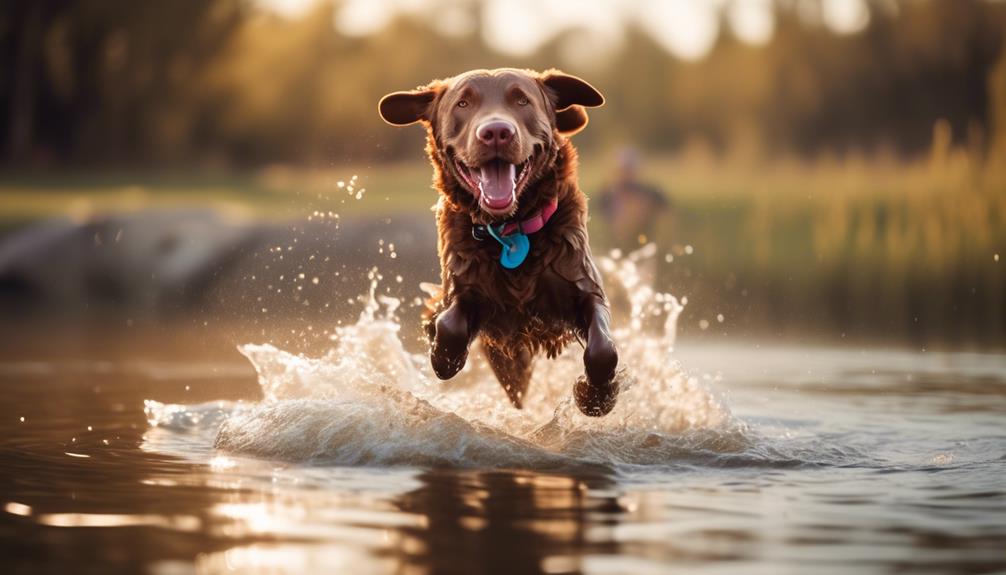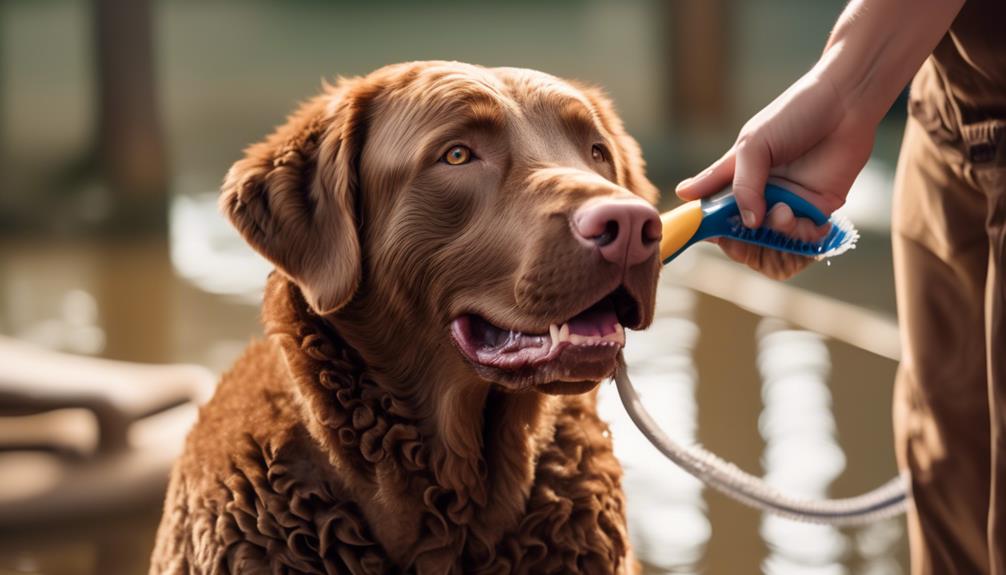Is the Chesapeake Bay Retriever truly the ultimate water dog? With its origins in the Chesapeake Bay region and its reputation for strength and intelligence, this breed certainly seems to fit the bill.
But what else sets it apart from other retrievers? From its adaptability in different living conditions to its unique tolerance for extreme weather, there is much to explore.
Stay tuned to uncover the fascinating traits and characteristics of the Chesapeake Bay Retriever, and discover why it has captured the hearts of so many dog lovers.
Key Takeaways
- The Chesapeake Bay Retriever is a medium to large-sized working dog originally from the Chesapeake Bay region of Maryland and Virginia.
- They were specifically developed to retrieve waterfowl in harsh conditions and have a strong and muscular build.
- The breed is adaptable to apartment living and suitable for novice owners, and they tolerate various weather conditions, including extreme temperatures.
- Chesapeake Bay Retrievers are highly energetic and require regular exercise, particularly activities like swimming, retrieving, and obedience training. They also require regular grooming and a balanced diet to maintain their health.
Origin and Size
The Chesapeake Bay Retriever is a medium to large-sized working dog that originated in the Chesapeake Bay region of Maryland and Virginia in the United States. This breed was specifically developed to retrieve waterfowl in the harsh and icy conditions of the Chesapeake Bay. They've a strong and muscular build, standing between 21-26 inches tall and weighing between 60-80 pounds.
The Chesapeake Bay Retriever is known for its thick, oily double coat that's water-resistant, which allows them to swim easily and stay warm in cold water. The coat comes in solid brown, sedge, or deadgrass color. With their impressive size and water-repellent coat, these dogs are well-suited for working in the water and retrieving game.
Adaptability and Living Conditions

Originating in the Chesapeake Bay region of Maryland and Virginia, the medium to large-sized Chesapeake Bay Retriever showcases impressive adaptability and living conditions. This breed adapts well to apartment living, making it a suitable choice for those in urban areas. However, there are factors to consider when choosing a dog for an apartment, such as exercise needs and noise level.
While some dogs may not be well suited to apartment living, the Chesapeake Bay Retriever is known to be a good fit for novice owners due to its adaptability and sensitivity level. Additionally, this breed tolerates various weather conditions, including both hot and cold temperatures. With its thick, water-resistant coat, the Chesapeake Bay Retriever can withstand the elements and thrive in different living environments.
Tolerating Weather Conditions

Chesapeake Bay Retrievers are known for their ability to tolerate a wide range of weather conditions. With their thick, oily double coat, these dogs are well-equipped to handle both cold and hot weather.
In colder temperatures, breeds with short coats and little body fat are more vulnerable to the cold, while Chesapeake Bay Retrievers, with their thick coats, are better protected. However, in hot weather, breeds with thick, double coats and short noses are more susceptible to overheating.
The Chesapeake Bay Retriever's water-resistant coat helps to regulate their body temperature and keep them comfortable in warmer climates. Additionally, their strong swimming abilities allow them to cool off in water, making them adaptable to various weather conditions.
Behavioral Traits and Exercise Needs

Behavioral traits and exercise needs of the Chesapeake Bay Retriever are important factors to consider when owning this breed. Here are three key points to understand:
- Aggression and fear: Chesapeake Bay Retrievers are generally not aggressive, but socialization and training are essential to ensure they develop proper behavior. Early socialization can help prevent fearfulness and ensure a well-adjusted dog.
- Tendency to bark or howl: Chesapeake Bay Retrievers are known to be vocal, and they may bark or howl to communicate their needs or alert their owners. This behavior can be managed through training and providing mental and physical stimulation.
- Exercise needs: This breed has high energy levels and requires regular exercise to stay physically and mentally healthy. They excel in activities such as swimming, retrieving, and obedience training. Daily walks, play sessions, and mental stimulation are necessary to prevent boredom and destructive behaviors.
Health, Care, and Feeding

When it comes to the health, care, and feeding of the Chesapeake Bay Retriever, there are several important factors to consider.
The Chesapeake Bay Retriever is generally a healthy breed, but like all dogs, they're prone to certain health issues such as hip dysplasia, progressive retinal atrophy, and various eye problems. Regular veterinary check-ups, vaccinations, and preventive care are essential to ensure their well-being.
In terms of care, the Chesapeake Bay Retriever has a thick, oily double coat that requires regular brushing to prevent matting and to maintain its water-resistant properties. Additionally, they're an active breed that requires regular exercise to keep them physically and mentally stimulated.
When it comes to feeding, it's important to provide them with a balanced diet formulated for their specific needs, taking into consideration their age, size, and activity level. Proper nutrition is vital to their overall health and longevity.
Additional Resources and Organizations

For additional resources and organizations related to the Chesapeake Bay Retriever, dog owners can explore a variety of options to support their knowledge and connect with fellow enthusiasts. Here are three valuable resources:
- Chesapeake Bay Retriever Club: The official breed club for Chesapeake Bay Retrievers provides information on breed standards, health concerns, and training tips. They also organize events such as dog shows and field trials, where owners can showcase their dogs' skills.
- Chesapeake Bay Retriever Rescue: This organization specializes in rescuing and rehoming Chesapeake Bay Retrievers in need. They offer adoption services, foster programs, and educational resources for potential adopters. They can provide guidance on the breed's specific needs and help match owners with the right dog.
- Online Forums and Communities: Joining online forums and social media groups dedicated to Chesapeake Bay Retrievers can provide a wealth of knowledge and support. These platforms allow owners to connect with experienced breeders, trainers, and fellow owners to exchange tips, ask questions, and share their love for the breed.
Frequently Asked Questions
Are Chesapeake Bay Retrievers Good With Children?
Chesapeake Bay Retrievers are generally good with children. They have a friendly and tolerant nature. However, it's always important to supervise interactions between dogs and children to ensure safety for both.
How Often Should I Groom a Chesapeake Bay Retriever?
A Chesapeake Bay Retriever should be groomed regularly to maintain their thick, water-resistant coat. It is recommended to brush them at least once a week to remove loose hair and prevent matting.
Do Chesapeake Bay Retrievers Have Any Specific Health Issues?
Chesapeake Bay Retrievers are generally healthy dogs, but they may be prone to certain health issues. Regular check-ups and a balanced diet are important to ensure their overall well-being.
Can Chesapeake Bay Retrievers Be Trained to Retrieve in Water?
Yes, Chesapeake Bay Retrievers can be trained to retrieve in water. They have a natural instinct for water retrieval due to their history as waterfowl hunting dogs. With proper training, they excel in this skill.
Are Chesapeake Bay Retrievers Prone to Separation Anxiety?
Chesapeake Bay Retrievers can be prone to separation anxiety. It is important for owners to provide them with proper training, socialization, and mental stimulation to help alleviate this issue.
What Are the Characteristics of a Chesapeake Bay Retriever?
The Chesapeake Bay Retriever is known for its strong endurance, intelligence, and loyalty. This breed is also characterized by its unique coat, which is water-resistant and can range in color from brown to red. If you’re interested in this breed, be sure to check out pictures of golden cocker retriever to see if it’s the right fit for you.
Conclusion
In conclusion, the Chesapeake Bay Retriever is a versatile and intelligent breed that can thrive in various living conditions, including apartment living.
While their thick double coat and short nose make them more susceptible to overheating, their adaptability to different weather conditions allows them to tolerate both hot and cold temperatures.
With regular exercise and proper care, this breed can make a great companion for novice owners.
Despite their tendency to bark or howl, their playfulness and trainability make them a popular choice for many households.




